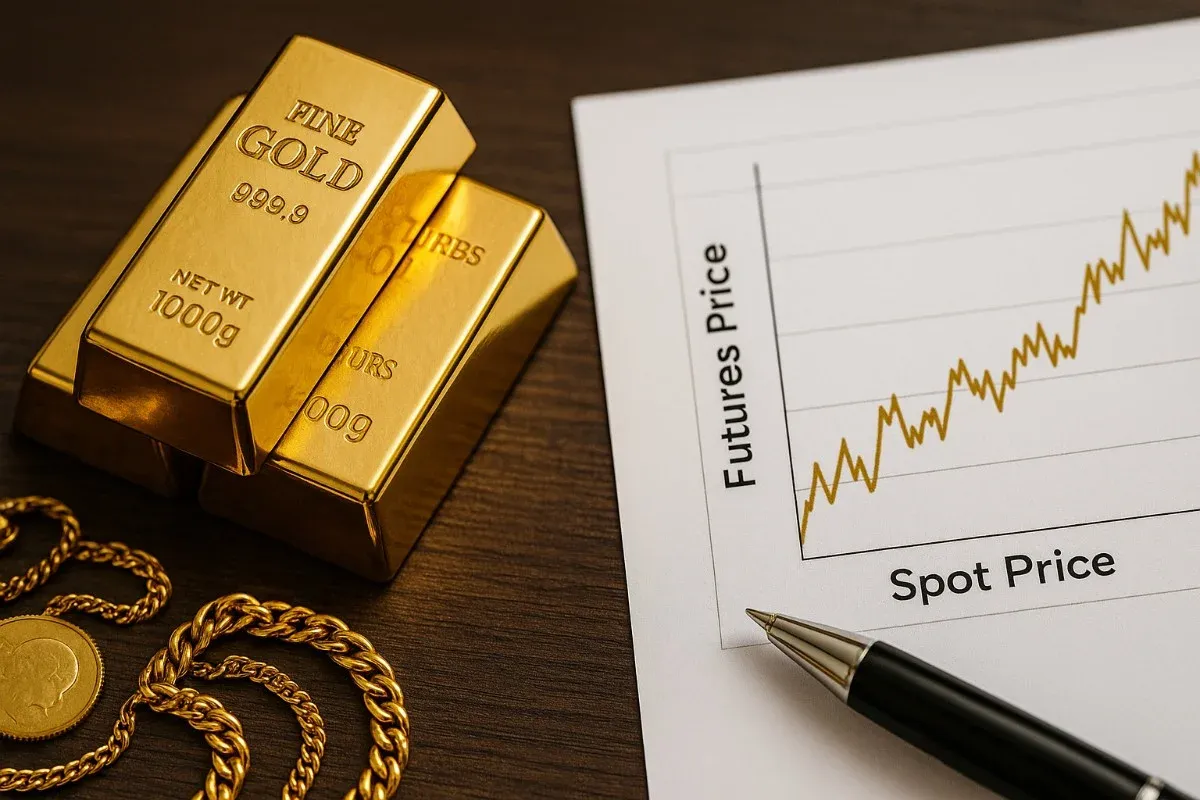Spot Price and Futures Price of Gold
What's The Difference
Between The Spot Price of
Gold And A Futures Price?
Understanding the difference between the spot price and the concept of "futures" pricing for gold (or any other commodity that is bought and sold) is extremely important for those who are navigating the investment marketplace.
It may seem odd that the same gold coin or gold bar could have two different monetary values, but that's exactly the case in commodities trading. Let's look into these differences.
What is the Spot Price of Gold?
The spot price of a commodity such as gold is defined as the cost of that particular commodity if it were purchased and delivered at the present moment. The key to spot pricing is immediacy. The transaction happens "on the spot" whereby the gold is delivered to the buyer and the compensation is handed over to the seller at the time the transaction is made. Bottom line, the spot price of gold or any commodity refers to its current value at the moment.
For the record, the spot price of gold in early April of 2024 was $2,293.13 per ounce or just under $74 per gram. This is a historic high time for the value of gold, which means it's a great time to turn any unwanted gold coins or jewelry into cash. One of the best ways to do it is with an online cash for gold buyer. These businesses operate with less overhead than jewelry stores and pawn shops and, therefore, can give you top dollar for your gold items.
What is a Gold Future?
This is where things get a little more complicated. The good news is if you are someone who is simply interested in selling gold coins or unwanted jewelry for an instant cash infusion you only need to concern yourself with the spot price of gold (the cash value gold buyers will base their offers on because you're selling at the moment).
Gold futures are a different story. Essentially, a "gold futures contract" is an agreement between a buyer and seller to transact the sale of gold at a future date based upon a price that is agreed upon at the time the contract is written.
In most cases, the futures price is based on the spot price plus what's called the "cost of carry", which essentially means how much it costs to store the gold, cover insurance, transport the gold, and pay for any other incidental expenses during the period with which the seller continues to hold the gold. There's also a risk-free interest rate (usually about 0.25%) attached to the purchase that begins on the date the contract is made and extends through the delivery date.
Confused? You're not alone. It is a complex calculation. For those interested in exploring and understanding the science of calculating futures in more depth, this is well explained by our friends at Investopedia. For the purposes of this post, however, we're going to stick with the basics.
What's The Strategy Behind Gold Futures?
This depends on which side of the equation you are on in the deal. If you're a seller, a future's price guarantees the security of locking in a reasonable price for your commodity and a concrete sales date. You know when you're going to sell and exactly how much you're going to be paid for your gold on that future date.
If you're a buyer, a future's contract is essentially a bet that the spot price of gold will go up. You're hoping the value of gold increases during the period between the contract date and the date of the actual transaction. If it does, you bought low and now have a commodity that's worth more than you paid for it.
For example, if the spot price of gold was $2,000 an ounce when you entered into a future's contract. Say your futures price with cost of carry and interest came in at $2005 per ounce. If, on the contracted date of the transaction, the market price of gold hits $2010 per ounce, you've turned a profit from day one. Depending on how much or how little gold you purchased, your profit could be significant or nominal. But you've certainly come out ahead.
Of course, if the value of gold plunges during the period between contract and final sale the opposite holds true. The buyer takes a loss.
What About Cash For Gold?
The reason that there is a historically strong market for gold is that it is one of the world's most stable commodities. The price certainly fluctuates but gold tends to be far more reliable than many other investments, which is why it is so often bought and sold.
But when it comes to working the gold futures game, that's best left to those who understand the market, know how to work it, can stay on top of it, and are willing to accept the inherent risk that comes with it.
However, getting top dollar for your unwanted gold items and jewelry is an entirely different ballgame. Anyone can do it, and the process has been made easier, safer, and more lucrative than ever before thanks to highly specialized online gold buyback companies
The spot price of gold is at historical highs right now, which means if you're looking to turn your old items into newfound cash, now's as good as any time to do it. You don't need to be a precious metals expert or an investment guru to get top dollar for your gold items.
Find a reputable online buyback company and you can expect a fair quote for your items based on the spot price of gold. Agree to the offer and you'll have cash in hand in about a day or two - not a bad way to do business.
